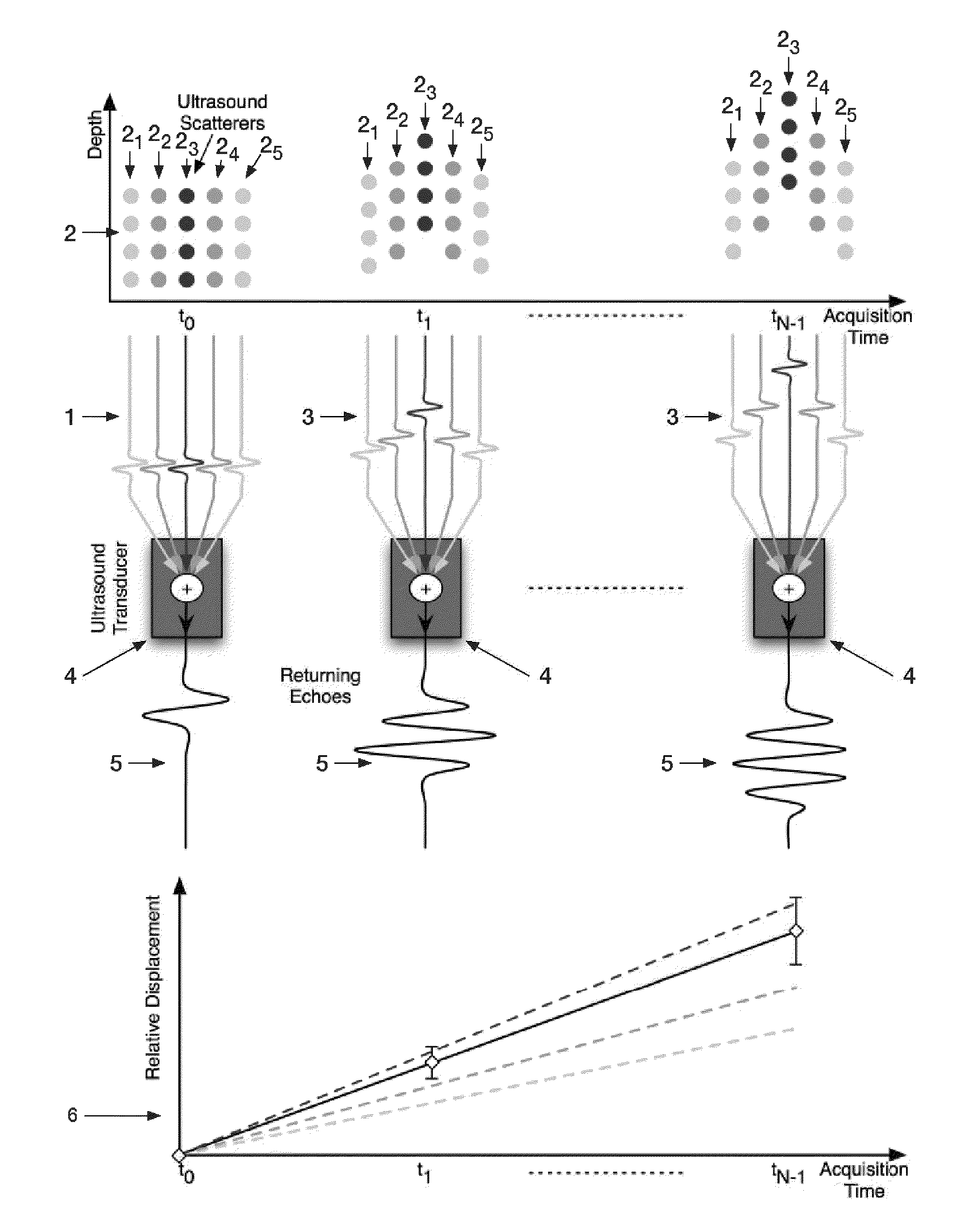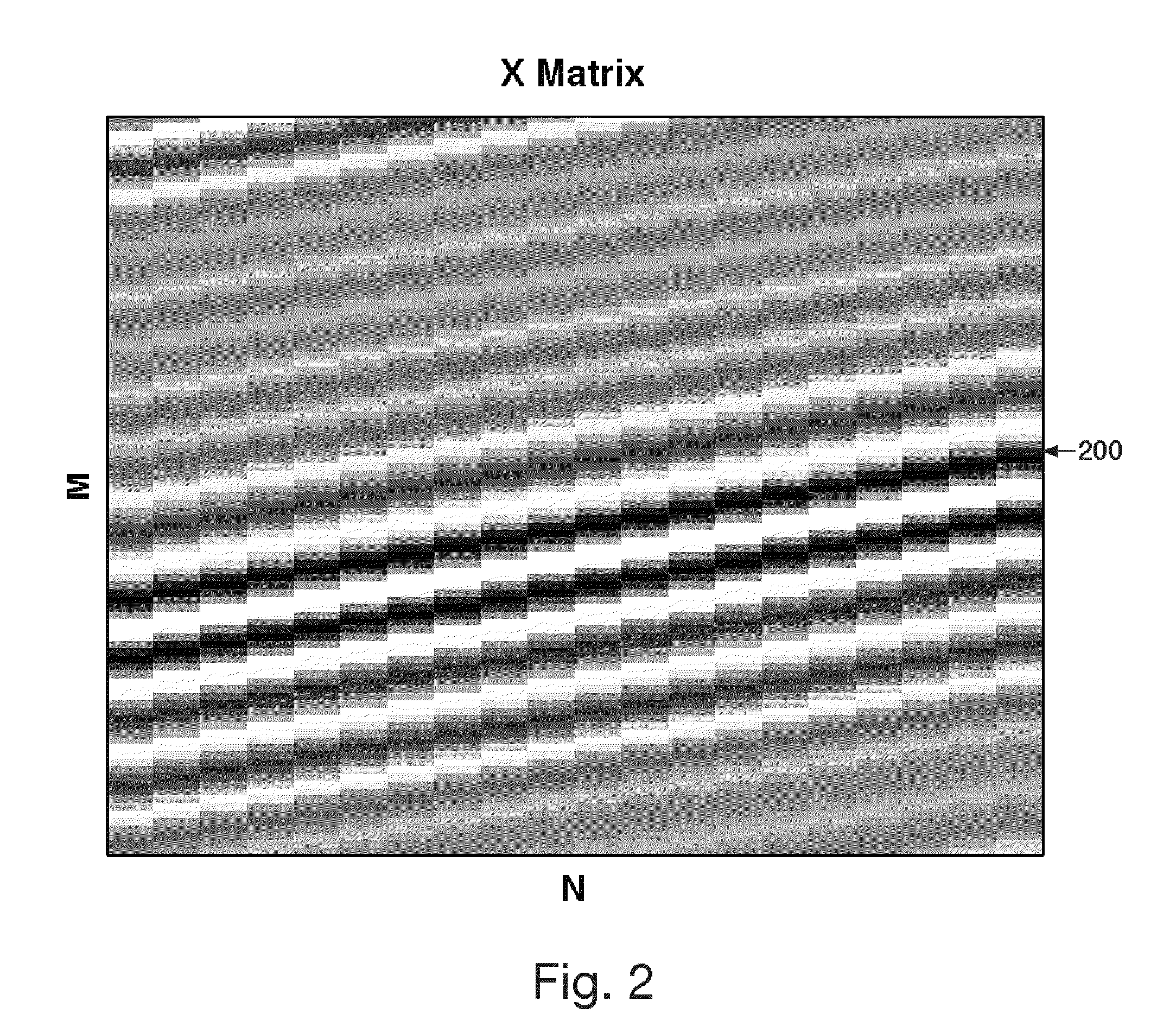Reduction of echo decorrelation facilitating motion estimation
a motion estimation and echo decorrelation technology, applied in the field of array-based imaging and sensing, can solve the problems of low probability, small magnitude of jitter errors, and false peak errors at integer multiples of signals
- Summary
- Abstract
- Description
- Claims
- Application Information
AI Technical Summary
Benefits of technology
Problems solved by technology
Method used
Image
Examples
example 1
Simulation Methods—PCF
[0180]To assess the performance of the PCA filtering technique (PCF), broadband ultrasound signals were simulated with varied SNR, delay, TDE window length, and PCF window length. Synthetic ensemble data 302 was constructed by summing a desirable, peak delay signal with two undesirable, lower energy signals that mimicked a range of displacements across the acoustic beam. These simulations were analyzed to determine the ability of complex PCF to separate the desired, peak displacement signal from the undesirable and decorrelating signals present in the lateral regions of the tracking beam. An illustration of the physical basis for the decorrelation model is shown in FIG. 1.
[0181]TDE was applied to simulated data that had undergone bandpass filtering, PCF, or both. TDE performance was analyzed in terms of signal correlation, root mean square (RMS) error between the estimated and true delay profile, and standard deviation. In performing PCF, only the first PC was ...
example 2
Complex PCF for Sonorheometry Displacement Estimation
[0215]By observing the dynamic displacements induced in blood by acoustic radiation force, sonorheometry provides a noncontact means for assessment of blood coagulation in vitro. In this sonorheometry example, radiation force ultrasound was used to transfer momentum to coagulating blood and ultrasound tracking methods were used to track resulting displacement. As a means to improve echo correlation and displacement estimation in sonorheometry, complex PCF was applied to experimental RF data.
[0216]RF data was acquired using a 10 MHz, 1.0-cm diameter single-piston transducer (General Electric Panametrics V327, Waltham, Mass.) with a 4.0 cm focal length. The piston transducer was coupled to a custom designed sonorheometry system (e.g., see FIG. 8A, 800), which included two transmit channels 808, four receive channels 804 / 808, an FPGA 810, and power supply circuitry 812. Received echoes were bandpass filtered, digitized at 65 MHz with...
example 3
Complex PCF for Improved Blood Velocity Estimation
[0223]Complex PCF was also applied to M-mode (where “M” stands for “motion”) RF data obtained in the left carotid artery of a twenty-three year old healthy male subject. In this experimental setting, ensembles of raw RF echo data were collected at a sampling frequency of 40 Mhz, PRF of 10 kHz, and a center frequency of 5 MHz using an Ultrasonix Sonix PP scanner and a L14-5 linear array transducer (Ultrasonix, Vancouver, BC, Canada). The scanner was modified to acquire an ensemble of one hundred fifty six A-lines from transmitted pulses with a fractional bandwidth of approximately twenty-five percent. Returning echoes from the carotid artery were arranged into thirteen ensembles with twelve A-lines per ensemble. Wall filtering was performed across the slow time dimension with a 50 tap, digital FIR high pass filter that had a cutoff frequency of 120 Hz. The ensembles were then processed using a conventional blood velocity estimation te...
PUM
 Login to View More
Login to View More Abstract
Description
Claims
Application Information
 Login to View More
Login to View More - R&D
- Intellectual Property
- Life Sciences
- Materials
- Tech Scout
- Unparalleled Data Quality
- Higher Quality Content
- 60% Fewer Hallucinations
Browse by: Latest US Patents, China's latest patents, Technical Efficacy Thesaurus, Application Domain, Technology Topic, Popular Technical Reports.
© 2025 PatSnap. All rights reserved.Legal|Privacy policy|Modern Slavery Act Transparency Statement|Sitemap|About US| Contact US: help@patsnap.com



